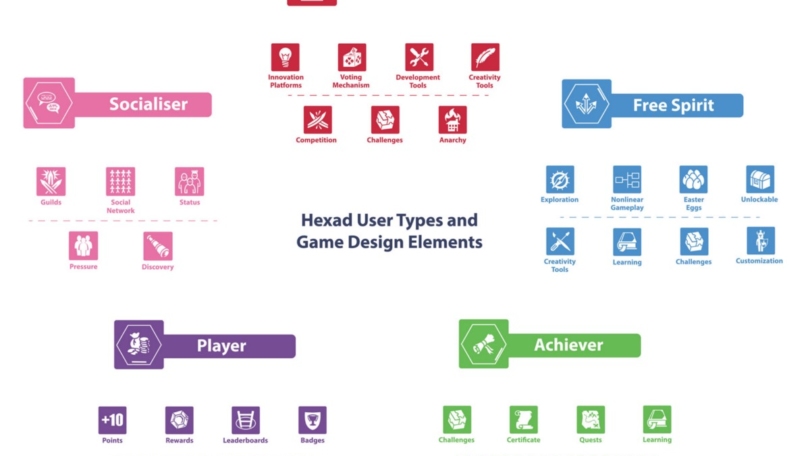Last week, Ryerson University‘s Chang School of Continuing Education organized a one-day professional development and networking event in Toronto, Canada. The event focused on serious games and gamification for three specific application areas: higher education, healthcare, and corporate. Several dozens of attendees spent the day discussing how to efficiently employ gamification for their needs, what are the pitfalls to avoid, and what are the general guidelines for success.
I attended the corporate track, so I can comment on the presentations in more detail.
An Coppens: gamification in change management
An Coppens, Founder and Chief Game Changer of Gamification Nation, talked about Gamification in change management: enabling employee motivation, engagement, and efficiency. She highlighted the importance of following a process of gameful design, which beings with first fully understanding the needs of the organization, or in other words, what organizational issue will be solved with the gameful system. Next, it is important to understand the needs of the users, i.e., what goals people need to accomplish and particularly what motivates them. Only after understanding these two parts — the business and the users — is when designers should begin thinking about game elements to satisfy the identified needs. An also pointed out that people cannot be gamified, only processes. Therefore, instead of changing the people involved, gamification projects should identify the organizational processes that must be improved and work on them. Lastly, she also remembered that gamification by itself does not fix broken processes. Thus, sometimes the processes need to be improved before they can be successfully gamified.
Starting the corporate track of #ChangSchoolTalks with @AnCoppens talking about #Gamification in Change Management pic.twitter.com/dOLcbadaHP
— Gustavo Tondello (@GustavoTondello) May 3, 2018
Marigo Raftopoulos: win conditions for gamification projects
Dr. Marigo Raftopoulos, Founder and Principal Consultant of Strategic Innovation Lab, talked about the win conditions to ensure success in gamification projects. She noted that failure in gamification projects can be of three types:
- operational: when the system’s design, technology, or implementation fail to solve the needs;
- strategic: when the problem is not well understood, the proposed solution is not adequate, or the communication is not adequate within the project;
- systemic: which are the hardest problems to solve, occur when the existing organizational structure, the mental models of the people involved, or the legacy systems hinder the ability to innovate.
To ensure success, Marigo argued that a gamification design process must include seven steps: system modelling, identification of objectives, empathy (understanding the people involved), creative problem solving, adequate use of technology, adequate use of gamefulness, and prototyping. Skipping any one of these steps might likely lead the project to some kind of failure.
Now, @marigo talks about win conditions to ensure success in enterprise #gamification projects at #ChangSchoolTalks pic.twitter.com/sgIOojQOBC
— Gustavo Tondello (@GustavoTondello) May 3, 2018
Pete Jenkins: big data and gamification
Pete Jenkins, Founder and Consultant at Gamification+, spoke about Big Data and Gamification. After defining and presenting examples of each concept separately, Pete suggested four different ways in which big data and gamification could be used together to create innovative solutions:
- Games to crowdsource big data analysis, with the example of FoldIt, a game that allowed laypersons to help solve a protein folding problem that was being studied by scientists for more than a decade.
- Gamification to generate big data, with the example of LinkedIn, that uses subtle gamification elements, such as the profile completion percentage, to nudge people into adding more information into the system.
- Gamification to visualize big data. In this regard, Pete noted how games can usually provide a lot of information on their screen to help players make informed decisions, in a graphical format, without showing reports or charts.
- Finally, big data can be used to generate more engaging activities for users. With the amount of data collected, machine learning and other personalization algorithms can be used to understanding each individual user’s preferences, thus enabling applications to personalize their experience.
And @petejenkins is now presenting about #gamification and big data at #ChangSchoolTalks pic.twitter.com/HizSDKpCnf
— Gustavo Tondello (@GustavoTondello) May 3, 2018
Panel: Can learning happen through play?
After the talks, the event closed with a discussion panel, followed by a networking time. The panel also featured An Coppens, Marigo Raftopoulos, and Pete Jenkins, as well as Sylvester Arnab, Professor and researcher in Game Science at Coventry University, Beth Rogozinski, serious entrepreneur, technology professional, and business strategist, focused on digital medicine, and Dr. Walter Greenleaf, research neuroscientist and medical product developer at Stanford University. The panel was facilitated by Dr. Atsusi Hirumi, Professor of Instructional Design and Technology at the University of Central Florida.
Responding to questions from the facilitator and the audience, the panelists highlighted the need to co-create to ensure the success of gamification projects. In other words, the users and all involved stakeholders should be part of the design process and feel ownership of the product they are creating. The panel also discussed the importance of balancing intrinsic and extrinsic motivators in gameful design. Another aspect that was mentioned was the benefit of learning from many types of games to improve the skills as a gamification designer, from tabletop to digital and to virtual reality games, from entertainment to serious games.
Pioneers are gathered today #ChangschoolTalks @changtalks pic.twitter.com/VoCQYDDrUD
— Naza (@Naza_Djafarova) May 3, 2018
This event resulted in a very productive day, both for the academic audience present as well as practitioners and attendees interested in finding out how gamification can help their organizations and improve their learning activities.
If you wish to learn more about gamification and how it can be used to help you engage your employees, create engaging learning activities, or design better healthcare products, visit the website of my new company MotiviUX and get in touch for more information!



